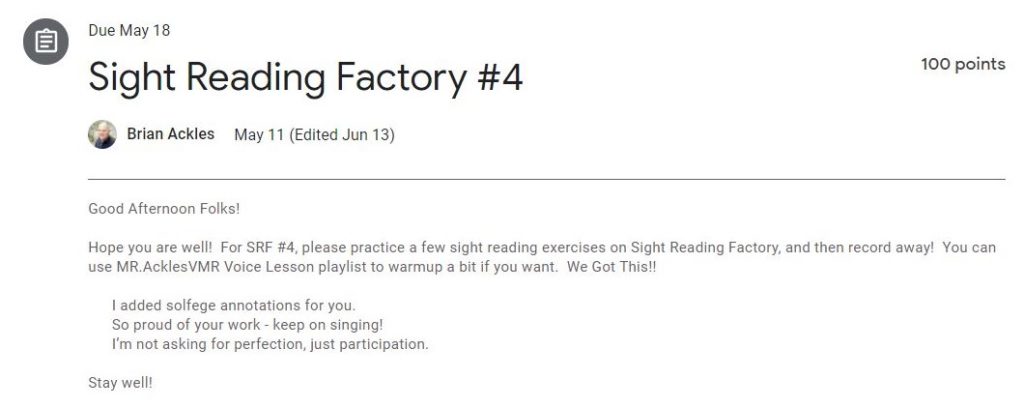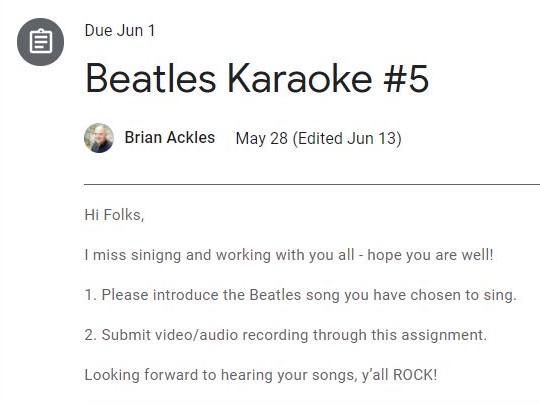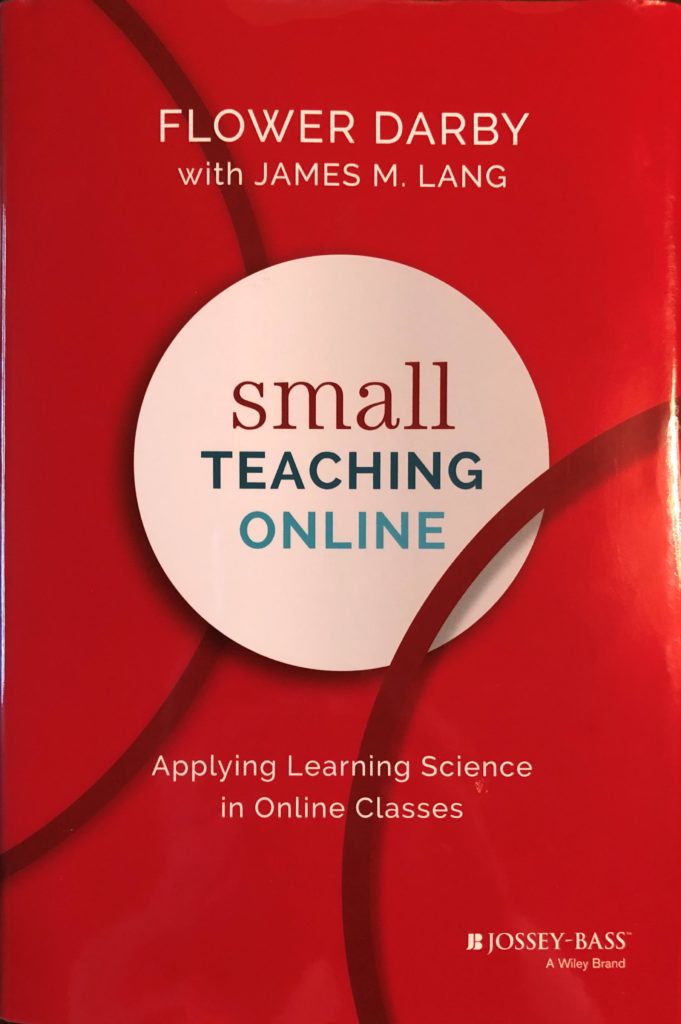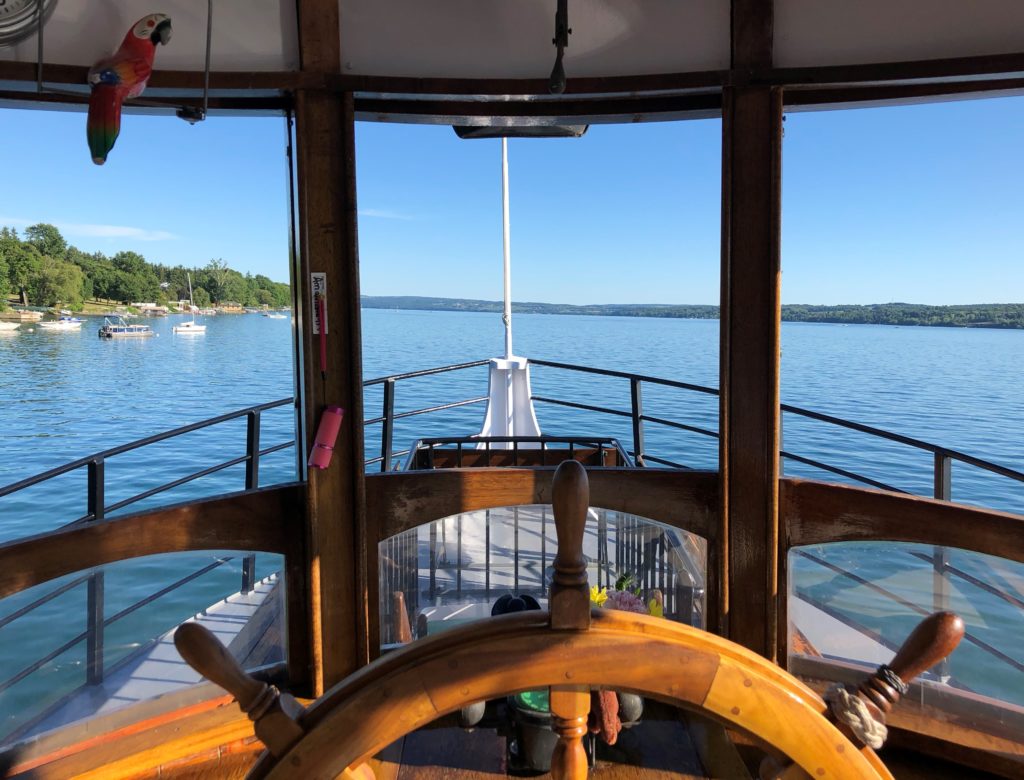I used the phrase above to introduce my students to their last in-class activity before we left for online learning this Spring. It was titled “What Would it Look Like”? I was interested in getting their input and ideas on what online choir assignments might look like. The objective of this activity was to have each student brainstorm and create choir assignments that they would consider enjoyable and serve as a break from their other schoolwork.
A Community of Practice
As my classes discussed online learning that day, each ensemble decided to continue their work on sight-reading and to keep their singing skills strong. Several students came up with the idea of creating an assignment called Choir Karaoke in which choir members would learn and sing their part along with a YouTube video or choir/piano recording. Many students also expressed their desire to continue learning new music for our future choir concerts and music festivals.
So on Friday, March 13th (the last day of classes), my student teacher and I prepared the music for the students’ choir folders for pick-up and after school. When the students left school that afternoon, I did not know if we would be back together after spring break (three weeks away), or sometime later. To be honest, I thought we would be back at school in plenty of time to prepare for our spring concert in June. I was mistaken.
Welcome to Distance Learning
For the first two weeks of distance learning, my class assignments required choir members to create student accounts on several free online platforms. My main objective was to get the students accustomed to participating and engaging in online learning. I also wanted to provide them with a variety of resources they could use to help them continue working and developing their music skills at home.

I decided early on that all choir assignments would take about 15-20 minutes to complete. That perfection would not be our goal – active participation was the final destination for my online choir. To help them be successful in this new environment, each time I posted an assignment on Google Classroom, I provided a link to a virtual timer. I found out very quickly that most students were having difficulty with their time management skills, and that participating in a virtual educational environment was a huge challenge.
I also offered weekly virtual office hours so that we could stay connected as a group, and I wanted the choir to know that I was still available to them for help if they had any questions or concerns. Sadly, a few of my choir members completely shut down and did not participate in any online assignments for the remainder of the year. Below are the statistics from my three ensembles.
Participation Statistics
9-10 Women’s Choir Participation Rate – 78.9%
- Out of 19 Students, 15 Students participated in online learning.
- 4 choir members did not participate in any online assignments or class meetings.
9-12 Concert Choir Participation Rate – 95.7%
- Out of 47 Students, 45 Students participated in online learning.
- 2 choir members did not participate in any online assignments or class meetings.
9-12 Select Choir Participation Rate – 95.8%
- Out of 24 Students, 23 Students participated in online learning.
- 1 choir member did not participate in any online assignments or class meetings.
In Choir, We Sing
By week four, I finally started to find my groove with distance learning. I posted one to two assignments per week, with one activity always containing some form of singing. To accomplish this, I used Sight Reading Factory or the Choir Karaoke assignment my students developed a few weeks earlier.

At first, a few students were reluctant to record their singing, but I assured them that I would be the only one to see and hear their recording. I also emphasized that if they felt uncomfortable recording a video of their performance, an audio submission would be okay. The reality is – in choir, we sing.

Performance Statistics
(The following data is based on choir members who participated in some or all online assignments. Students who did not participate in any online learning are not represented in the percentages below)
9-10 Women’s Choir (Participation Rate 78.9%)
- Sight Reading Factory – 72%
- Choir Karaoke – 95.3%
9-12 Concert Choir (Participation Rate 95.7%)
- Sight Reading Factory – 95.1%
- Choir Karaoke – 95.5%
9-12 Select Choir (Participation Rate 95.8%)
- Sight Reading Factory – 99.1%
- Choir Karaoke – 83.9%
As Musicians, We Plan
Several class assignments also included non-performing activities that incorporated our work with ADIF Self-Sprints. The purpose of Self-Sprints is to provide the students with opportunities to plan, practice independently, and take ownership and responsibility of their music-making. I discovered that Flipgrid and Google Forms worked very well for this application.
Flipgrid
Through Flipgrid, I was able to record a video of myself introducing and explaining the Self-Sprint assignment to my ensembles. Students then recorded and submitted a short two-minute video describing the music and the steps they planned to take in learning their assigned song.

Looking back, I now realize how important the Flipgrid video platform was for both the students and myself as it provided a well desired and needed connection that we loss as the classes went online. Each of my ensembles planned, rehearsed, and performed individually on the following selections:
Women’s choir – I see the light, from TANGLED.
Concert Choir – The Seal Lullaby, Eric Whitacre
Select Choir – Moon River, from BREAKFAST AT TIFFANY’S
The video below is from one of my sopranos in the Women’s Chorus.
Google Forms
Once I got the hang of using Google Forms, it worked exceptionally well. It provided the students with a template they could utilize for their rehearsal planning and provided me with data and a form of assessment. The attached document is from a Google Form that I created for my Select Choir as they learned and prepared Moon River. The reality is – as musicians, we plan.
Non-Performance Statistics
(The following data is based on choir members who participated in some or all of the online assignments. Students who did not participate in any online learning are not represented in the percentages below)
9-10 Women’s Choir (Participation Rate 78.9%)
- Google Forms – 88.6%
- Flipgrid – 82%
9-12 Concert Choir (Participation Rate 95.7%)
- Google Forms – 95.5%
- Flipgrid – 89.5%
9-12 Select Choir (Participation Rate 95.8%)
- Google Forms – 96.9%
- Flipgrid – 86.9%
Professional Reading – A must for the summer
One book that I am currently reading is titled Small Teaching Online. It contains a lot of excellent information and is providing me with some understanding of some of my distance learning successes and failures. One of my accomplishments was that through all my online assignments, I had one consistent goal: to keep my students singing and participating in making music while they were at home.

One area I struggled in was giving feedback and grading the students’ work in a timely manner. I felt a bit overwhelmed this Spring, for I was working on five different online assignment and grading platforms – this got brutal. For example, I would grade and respond to my students through Flipgrid, document the assignment completion and grade in Google Classroom, and then post the grade on the district’s virtual grade book, SCHOOLTOOL. And that was only one assignment!
Conclusion: Something to Look Forward To
My ultimate objective during online learning this Spring was to keep the students singing and musically engaged as much as possible. It was a challenge to find a good balance between performance and non-performance online assignments and activities. For me, since we sing and plan during our choir rehearsals, then we need also to find ways to sing and plan through online platforms.
I am not sure how my participation numbers compare to other ensembles, but I hope that the assignments I designed and implemented were strong in rigor, while also light on stress for my students. I wanted “choir” to remain an activity they enjoyed, and hopefully, next year, it will continue to be something for them to look forward to.
On A Personal Note

Each summer during July and August, I work as a boat captain for Mid-Lakes Navigation’s mailboat and sightseeing tours on Skaneateles Lake in Central New York. It is a gorgeous lake, just southwest of Syracuse. I get to work with some great people, and I enjoy meeting and talking with our guests. For me, working on the lake helps me step away from music for a bit and recharge from the previous year. The next Leading Voices blog will be posted on August 5th.
So, if you are ever in Central New York this summer and drive through the Finger Lakes region, stop by Skaneateles Lake and come take a ride. And when you book your cruise, don’t forget to check and see if captain Backles is driving – you will not be disappointed.



mary lou beck says
Thank you for this information. I really enjoyed listening to the song “I See the Light”. I think my choir will enjoy singing this work. Do you have any other suggestions of choral favorites from your choir?
Mary Lou Beck
Brian O Ackles says
Hi Mary Lou,
Here are a few tunes the ladies (SSA) were going to sing for our spring concert this year. Maybe we will be able to sing a few of these next year?
Best,
Brian
Seasons, Ola Gjeilo
https://www.youtube.com/watch?v=3WeNaN0sgV4
The Blessing, Arr. John Purifoy
https://www.youtube.com/watch?v=iWQlyuJBFBs
Take Five, Arr. Kirby Shaw
https://www.youtube.com/watch?v=9l6LvkrII2o
A Million Dreams, Arr. Roger Emerson
https://www.youtube.com/watch?v=22uwSUOuamA
mary lou beck says
Thank you for the suggestions. We have enjoyed singing A Million Dreams as well!
Enjoy your summer.
Susan McMane says
Thank you for this inspiring article. I loved your resources and showing your student’s work. I’m going to use some of your ideas next fall.
Brian O Ackles says
Thanks for the feedback Susan. The ADIF Self-Sprints work great with the students – let me know how it goes in the Fall.